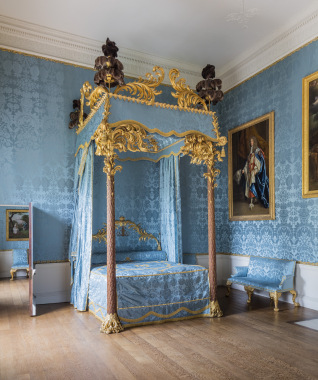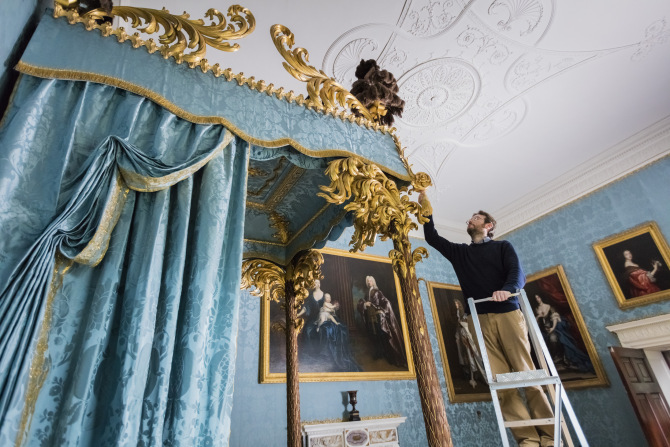The return of a lavishly carved and decorated 18th century state bed to the National Trust’s Kedleston Hall in Derbyshire marks the final stage of an exciting 30 year restoration journey.

Simon McCormack, conservation manager at the National Trust’s Kedleston Hall, puts the finishing touches to the state bed which has returned following restoration. Credit National Trust Images/James Dobson.
The restoration of 11 rooms on the state floor of the historic Hall, designed by Neoclassical architect Robert Adam as a spectacular show house for his client Nathaniel Curzon, has involved countless skilled carvers, gilders, painters and conservators.
The unique bed was also designed by Adam and is believed to have been made by Kedleston’s carvers under Derby carver James Gravenor in 1768. However, over time it had become badly damaged and extensive work was needed to repair broken carvings and flaking gilding, and replace silk upholstery and handmade gold lace and braid.
Simon McCormack, conservation manager at Kedleston Hall, said: “The state bed is the jewel in the crown of Kedleston Hall’s furniture and is by far the most magnificent item on the state floor, which was designed as a lavish entertaining space for 18th century guests of the Curzon family. Within the state floor is a three-room state apartment, in which the bed took centre stage. Beds such as these were designed in the hope of a Royal visit, although sadly this never took place at Kedleston.

Simon McCormack, conservation manager at the National Trust’s Kedleston Hall, puts the finishing touches to the state bed which has returned following restoration. Credit National Trust Images/James Dobson.
“Of all the luxurious materials deployed at Kedleston, the most expensive were reserved for the state bed with its gold lace and braid, and it was easily the biggest item of furniture created for the house.
“It is incredibly exciting to see the return of this magnificent piece of furniture; it is the icing on the cake in this remarkable 30 year project.”
Kedleston was one of the first neoclassical houses to be built in Britain and Robert Adam went on to become one of the most important British architects of all time.
Adam was originally employed to landscape the idyllic parkland and design its buildings, but was soon asked to complete the design for the Hall itself.
As part of the 30 year restoration project, the original suite of 11 state rooms which make up the main part of the house, have been returned to their former glory. This part of the house was designed purely for entertainment and to impress the Curzons’ guests and visiting tourists and was never intended for comfort or day–to-day living.
Although the rooms have retained almost all of their original treasures, they had been redecorated over time and generations of use and exposure to sunlight had led to interior damage.
Using archive material and cutting edge technology to analyse paint samples, the original paint schemes have now been faithfully restored.
Highly skilled traditional craftsmanship has brought back to life the original collections, precious gilt furniture and works of art. Over 1500 metres of bespoke silk damask have been hung on the walls in the three-room state apartment alone, the designs taken from surviving scraps of the original fabric.
Simon McCormack added: “This has been a project on a massive scale with incredible attention to detail being paid at every stage of the restoration of each of the 11 rooms on the state floor.
“We are immensely grateful to everyone who has been involved in this extraordinary restoration journey. From the time it was built, country house tourists would flock to Kedleston to marvel at its interiors. This project has brought Kedleston back to life and our visitors will now be able to enjoy this unique space just as they would have done in the 18th century.”
The funding for the conservation charity’s project at Kedleston was made possible thanks to the support of Kedleston’s visitors and members. Kedleston has also been awarded grants from the Royal Oak Foundation and the John Cornforth Memorial Appeal.
For further information and visiting times see https://www.nationaltrust.org.uk/kedleston-hall.



